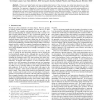Free Online Productivity Tools
i2Speak
i2Symbol
i2OCR
iTex2Img
iWeb2Print
iWeb2Shot
i2Type
iPdf2Split
iPdf2Merge
i2Bopomofo
i2Arabic
i2Style
i2Image
i2PDF
iLatex2Rtf
Sci2ools
VIS
2007
IEEE
2007
IEEE
Two Level Approach to Efficient Visualization of Protein Dynamics
Proteins are highly flexible and large amplitude deformations of their structure, also called slow dynamics, are often decisive to their function. We present a two-level rendering approach that enables visualization of slow dynamics of large protein assemblies. Our approach is aligned with a hierarchical model of large scale molecules. Instead of constantly updating positions of large amounts of atoms, we update the position and rotation of residues, i.e., higher level building blocks of a protein. Residues are represented by one vertex only indicating its position and additional information defining the rotation. The atoms in the residues are generated on-the-fly on the GPU, exploiting the new graphics hardware geometry shader capabilities. Moreover, we represent the atoms by billboards instead of tessellated spheres. Our representation is then significantly faster and pixel precise. We demonstrate the usefulness of our new approach in the context of our collaborative bioinformatics p...
IEEE Visualization | Large Amplitude Deformations | Large Protein Assemblies | Two-level Rendering Approach | VIS 2007 | Visualization |
| Added | 03 Nov 2009 |
| Updated | 03 Nov 2009 |
| Type | Conference |
| Year | 2007 |
| Where | VIS |
| Authors | Ove Daae Lampe, Ivan Viola, Nathalie Reuter, Helwig Hauser |
Comments (0)

